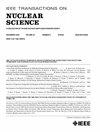空间辐射环境中用于位移损伤监测的p-i-n二极管校准
IF 1.9
3区 工程技术
Q3 ENGINEERING, ELECTRICAL & ELECTRONIC
引用次数: 0
摘要
本文研究了特殊研制的长基硅p-i-n二极管作为传感器测量硅中的位移损伤剂量(DDD)的响应。DDD的测量是基于辐照p-i-n二极管的正向电压位移($\Delta V_{F}$)。在本工作中,将p-i-n二极管辐照在以下辐射场中:1)来自医用直线加速器(LINAC)的20 mev电子;2)格罗宁根质子治疗设施的200、150和100兆电子伏质子;3) 4.63 mev和15.3 mev准单能中子。结果表明,校准因子($\alpha $),即p-i-n二极管的响应,用20 mev电子获得的DDD,可以用来预测p-i-n二极管对质子和中子的响应,如上述(在实验误差范围内)。然而,与100 mev质子相关的p-i-n二极管响应为70% higher response than predicted, which requires further investigation. Overall, the 20-MeV electrons from a medical LINAC were found to be suitable for p-i-n diodes calibration in terms of the non-ionizing energy losses (NIELs) and are widely available in contrast to 1-MeV electrons, fast neutrons, and protons.本文章由计算机程序翻译,如有差异,请以英文原文为准。
Calibrating p-i-n Diodes for Displacement Damage Monitoring in a Space Radiation Environment
This work investigates the response of specially developed silicon p-i-n diodes with a long base as sensors to measure displacement damage dose (DDD) in silicon. Measurements of DDD are based on the forward voltage shift ( $\Delta V_{F}$ ) of irradiated p-i-n diodes. In this work, the p-i-n diodes were irradiated in the following radiation fields: 1) 20-MeV electrons from a medical linear accelerator (LINAC); 2) 200-, 150-, and 100-MeV protons at the Groningen proton therapy facility; and 3) 4.63- and 15.3-MeV quasi-monoenergetic neutrons at the Czech Technical University, Prague. It was demonstrated that the calibration factor ( $\alpha $ ), which is the response of the p-i-n diode in terms of DDD obtained using 20-MeV electrons, can be used to predict the p-i-n diode response for protons and neutrons as mentioned above (within experimental error). However, the p-i-n diode response related to 100-MeV protons has a 70% higher response than predicted, which requires further investigation. Overall, the 20-MeV electrons from a medical LINAC were found to be suitable for p-i-n diodes calibration in terms of the non-ionizing energy losses (NIELs) and are widely available in contrast to 1-MeV electrons, fast neutrons, and protons.
求助全文
通过发布文献求助,成功后即可免费获取论文全文。
去求助
来源期刊

IEEE Transactions on Nuclear Science
工程技术-工程:电子与电气
CiteScore
3.70
自引率
27.80%
发文量
314
审稿时长
6.2 months
期刊介绍:
The IEEE Transactions on Nuclear Science is a publication of the IEEE Nuclear and Plasma Sciences Society. It is viewed as the primary source of technical information in many of the areas it covers. As judged by JCR impact factor, TNS consistently ranks in the top five journals in the category of Nuclear Science & Technology. It has one of the higher immediacy indices, indicating that the information it publishes is viewed as timely, and has a relatively long citation half-life, indicating that the published information also is viewed as valuable for a number of years.
The IEEE Transactions on Nuclear Science is published bimonthly. Its scope includes all aspects of the theory and application of nuclear science and engineering. It focuses on instrumentation for the detection and measurement of ionizing radiation; particle accelerators and their controls; nuclear medicine and its application; effects of radiation on materials, components, and systems; reactor instrumentation and controls; and measurement of radiation in space.
 求助内容:
求助内容: 应助结果提醒方式:
应助结果提醒方式:


